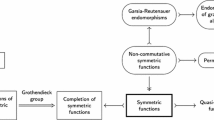Abstract
From classical and quantum mechanics we abstract the concept of a two-product algebra. One of its products is left unspecified; the other is a Lie product and a derivation with respect to the first. From composition of physical systems we abstract the concept of composition classes of such two-product algebras, each class being a semigroup with a unit. We show that the requirement of mutual consistency of the algebraic and the semigroup structures completely determines both the composition classes and the two-product algebras they consist of. The solutions are labelled by a single parameter which in the physical case is proportional to the square of the quantum of action.
Similar content being viewed by others
References
An investigation of two-product algebras, based on the duality between observables and generators in classical and quantum mechanics, is presented in E. Grgin and A. Petersen. J. Math. Phys.15, 764–769 (1974)
Mehta, C. L.: J. Math. Phys.5, 677–686 (1964)
See, e.g. Schafer, R. D.: An introduction to nonassociative algebras. Ch. V, section 3. New York: Academic Press 1966
Author information
Authors and Affiliations
Additional information
Communicated by R. Haag
Rights and permissions
About this article
Cite this article
Grgin, E., Petersen, A. Algebraic implications of composability of physical systems. Commun.Math. Phys. 50, 177–188 (1976). https://doi.org/10.1007/BF01617995
Received:
Issue Date:
DOI: https://doi.org/10.1007/BF01617995



